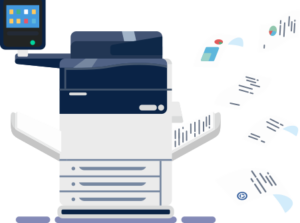In today’s fast-paced corporate environment, printing remains an essential part of everyday operations. However, the environmental impact of printing cannot be ignored. From paper waste to energy consumption, traditional printing practices contribute significantly to carbon emissions and resource depletion. Fortunately, there are steps that businesses can take to minimize their environmental footprint while still meeting their printing needs. Here are some strategies for making your office printing more environmentally friendly:
- Go Digital Whenever Possible: Before hitting the print button, consider whether the document truly needs to be printed. With advancements in technology, many documents can be viewed, shared, and stored digitally, eliminating the need for printing altogether.
- Choose Recycled Paper: When printing is necessary, opt for paper made from recycled materials. Recycled paper reduces the demand for virgin pulp, conserving trees and reducing energy consumption and greenhouse gas emissions associated with paper production.
- Print Double-Sided: Set your printers to default to double-sided printing. Printing on both sides of the paper reduces paper usage by half, cutting costs and minimizing waste.
- Minimize Margins and Font Sizes: Adjust document settings to reduce margins and font sizes, allowing more content to fit on each page. This simple adjustment maximizes paper usage and reduces the number of pages needed for printing.
- Invest in Energy-Efficient Printers: When upgrading or replacing printers, opt for energy-efficient models that are ENERGY STAR certified. Energy-efficient printers consume less electricity during operation, reducing carbon emissions and lowering energy costs.
- Utilize Print Management Software: Implement print management software to monitor and control printing activities. Print management software can track usage, set printing quotas, and encourage responsible printing behavior among employees.
- Promote Paperless Meetings: Encourage the use of digital documents and presentations during meetings to minimize paper usage. Utilize collaboration tools and project management software to share documents electronically and streamline workflows.
- Recycle Printer Cartridges: Properly dispose of used printer cartridges by recycling them. Many printer manufacturers and office supply stores offer cartridge recycling programs, preventing cartridges from ending up in landfills and conserving valuable resources.
- Educate Employees: Raise awareness among employees about the environmental impact of printing and the importance of adopting sustainable printing practices. Provide training on how to print responsibly and encourage employees to take advantage of digital alternatives whenever possible.
- Monitor and Evaluate Printing Practices: Regularly monitor printing activities and evaluate their environmental impact. Identify areas for improvement and implement changes to further reduce the environmental footprint of office printing.
By implementing these strategies, businesses can minimize their environmental impact while still meeting their printing needs. Green printing not only helps protect the environment but also reduces costs and promotes sustainability within the organization. Together, let’s make our office printing more environmentally friendly and contribute to a greener future.





